Phase II- The Investigation
Fieldwork
Teachers mapped out two streams on campus to visit. One small one called Campus Creek and another larger creek, Paint Branch Creek that was fed with water from Campus Creek.
Campus Creek
A short walk from the school is a small creek. In a preliminary visit the easiest access was discovered and extra vines were trimmed back. Children first discovered tracks on the beach and thought they might have been made by deer and raccoon. Though the fish were quick, a few were caught and brought back to the classroom for further observation along with a couple of water striders.
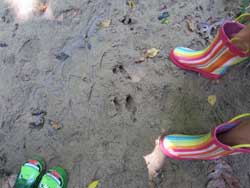
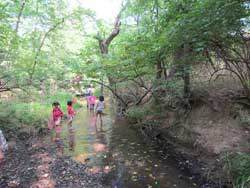
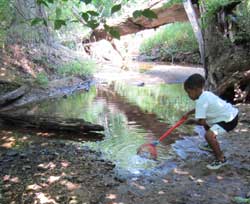
Paint Branch Creek
Our next field trip took us to a slightly wider creek that was fed by Campus Creek. This creek was teaming with small minnows and most children were able to catch some. A fisherman was scheduled to meet up with the group and he was able to pull bigger fish out with little trouble. The fisherman caught enough for each child to have the opportunity to hold one in their net for a closer look and then release them. A larget catfish was caught much to the delight of the children. On the way back home children stopped to take a break at different little pond and spied a hugh snapping turtle. When a bit of their bagel fell in the water the children were able to see its large head surface with a big snap!
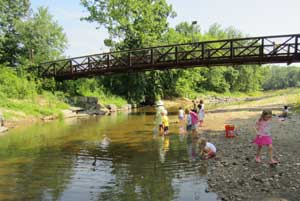
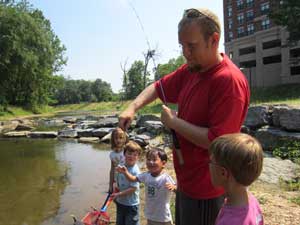
National Wildlife Visitor Center

The National Wildlife Visitor Center in Laurel Maryland, has expansive indoor exhibits as well as a teaching pond and a lake on its premises. Mr. Dennis Hartnett, a naturalist for the center, designed a program for the Green Room children around pond and stream life. Mr. Dennis met us as we got off the bus and showed us some skins of mammals that live around ponds and streams including raccoons, deer and ground hogs. Children were able to touch the skins and feel the different textures each animal had. Mr. Dennis explained that no animal had been killed for the exhibits, all had died of other causes and were preserved for the displays. Next we went on a scavenger hunt using a picture checklist. Children took turns crossing off each pond/stream item that they found. After the naturalist talk the class was free to explore the indoor exhibits. The trip was finished with a picnic by the lake listening and watching the Canada Geese skim across the water.
Visiting Experts
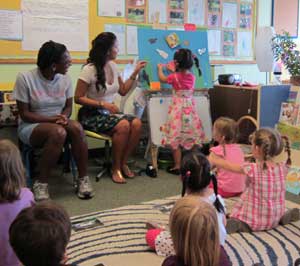
Environmental Scientist- Being located on the campus of a University gives the school many extra resources. Because some of the children noticed trash around the pond and stream, two environmental scientist undergraduate students agreed to come and talk to the children about the importance of keeping ponds and streams clean. They brought in a display of a pond with a factory, farm, and trash attached. After talking to the students a bit about how pollutants get into the water, the students were allowed to come up, remove the trash, and replace it with healthy pond animals.
Each child was given a fish puppet to decorate and as they did this, their words on why it is important to keep ponds and streams clean was written on the back.
Later some of the children helped write a story about a dirty pond to use with their puppets.
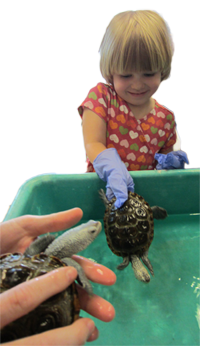
The Dirty Water by the Green Room Kids
Once upon a time there were some fish with different names. The fish were not happy. They were not happy because the water was dirty. The animals made the water dirty. They threw the trash in the water.
The Green Room teachers and children went to the stream and the pond. They saw the trash and said, "Oh no, look at all the trash!" and then they cleaned it up.
Pet Owner- Two Diamondback Terrapins were the next visitors. We found out that they like brackish water, or partially salted water and that they drink from their noses. Everyone had a chance to hold the turtles while wearing gloves. This visit was particularly appropriate since the University of Maryland mascot is the Diamondback Terrapin. The children dictated a long thank you letter to the visitor and her pets recalling all of the information they learned.
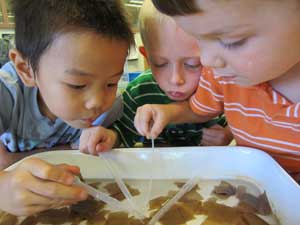
Biologist- An alumni parent (Dr. Bely) who works on the UM campus studying pond worms, came to teach the Green Room children a little about them and to talk about how they are prey. After the talk, children were able to pretend they were predators, sucking up the analoid worms with a pipette and placing them in another container. This exercise proved very engaging and also was a great exercise in fine motor skills. It took the children a little while to figure they needed to squeeze the air out of pipette first.
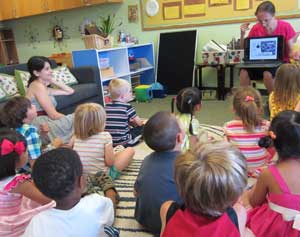 Microbiologist- What are some of the smallest living things? One of the parents, who is a microbiologist, brought this question up to the children during a group meeting presentation. First she talked about what is living and what is not. Some children believed that plants were not alive. A discussion arose about how plants grow and need food and water. In the end the children were able to distinguish that plants were indeed alive. The biologist also showed images of bacteria on her laptop. These are living things that you cannot see with your naked eye unless you grow a culture of them. She brought in some petri dishes with agar and allowed the children to each grow a culture by touching an object to the agar and sealing the dish off. A drop of pond water proved to be full of this microscopic life after a few days. This reinforced the habit of washing hands before eating etc.
Microbiologist- What are some of the smallest living things? One of the parents, who is a microbiologist, brought this question up to the children during a group meeting presentation. First she talked about what is living and what is not. Some children believed that plants were not alive. A discussion arose about how plants grow and need food and water. In the end the children were able to distinguish that plants were indeed alive. The biologist also showed images of bacteria on her laptop. These are living things that you cannot see with your naked eye unless you grow a culture of them. She brought in some petri dishes with agar and allowed the children to each grow a culture by touching an object to the agar and sealing the dish off. A drop of pond water proved to be full of this microscopic life after a few days. This reinforced the habit of washing hands before eating etc.
Representation
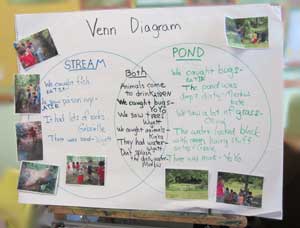
The pond and Campus Creek trips led nicely into a discussion about the difference between the two. A Venn Diagram was used to display the children's ideas. After a few examples the children were able to tell where on the diagram their words should be written and in what color marker.
Looking at the lesson plans, representation was a weekly endeavor. Representation came in the form of lists of what we know, what should we bring on our field trip, and how can we find the answers to our questions. Drawings and models were also encouraged. Children wrote daily in individual journals and some illustrations were about the ponds and streams we had visited.
Display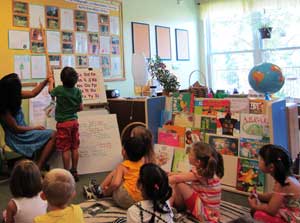
Children's drawings of the pond and their photographs were displayed on the bulletin board. Each child was able to talk about their drawings at a group meeting. This activity proved enjoyable for the children as each was proud of their work. It would have been optimal to have all drawings and pictures displayed at eye level but there wasn't enough room. Children used a pointer when discussing their work.
After enough information was attained to answer the children's individual questions and they had written them, these were displayed on the main bulletin board for all to see too. The final display of a pond model was prominently displayed for the entire school to enjoy and resulted in favorable response much to the pride of the children.
Information resources
Some of the books
we found useful but not a complete list
- Froggy Series by Jonathan London
- Pond Life a Golden Guide by George Reid
- Audubon field guide series including bugs, fish and reptiles
- What's Alive? by Kathleen Zoehfeld
- A Fishing Surprise by Rae McDonald
- Amazing Snakes by Sara Thompson
- Jump Frog Jump by Robert Kalan
- Make Way for Ducklings by Robert McCloskey
- Eye Witness Series, Pond and River and Amphibians
- Pond by Donald Silver
- Pond Year by Kathryn Lasky
- Pond Walk by Nancy Wallace
- In a Small Small Pond by Denise Fleming
- The Pig Pond by Martin Waddell
- In the Pond by Ermanno Cristini
- Turtle Splash byCathryn Falwell
- Philippe in Monet's Garden by Lisa Carmack

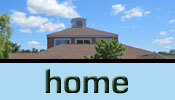
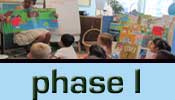
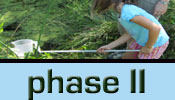
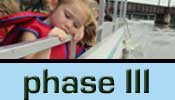
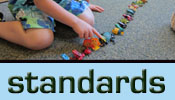









 Microbiologist- What are some of the smallest living things? One of the parents, who is a microbiologist, brought this question up to the children during a group meeting presentation. First she talked about what is living and what is not. Some children believed that plants were not alive. A discussion arose about how plants grow and need food and water. In the end the children were able to distinguish that plants were indeed alive. The biologist also showed images of bacteria on her laptop. These are living things that you cannot see with your naked eye unless you grow a culture of them. She brought in some petri dishes with agar and allowed the children to each grow a culture by touching an object to the agar and sealing the dish off. A drop of pond water proved to be full of this microscopic life after a few days. This reinforced the habit of washing hands before eating etc.
Microbiologist- What are some of the smallest living things? One of the parents, who is a microbiologist, brought this question up to the children during a group meeting presentation. First she talked about what is living and what is not. Some children believed that plants were not alive. A discussion arose about how plants grow and need food and water. In the end the children were able to distinguish that plants were indeed alive. The biologist also showed images of bacteria on her laptop. These are living things that you cannot see with your naked eye unless you grow a culture of them. She brought in some petri dishes with agar and allowed the children to each grow a culture by touching an object to the agar and sealing the dish off. A drop of pond water proved to be full of this microscopic life after a few days. This reinforced the habit of washing hands before eating etc. 

